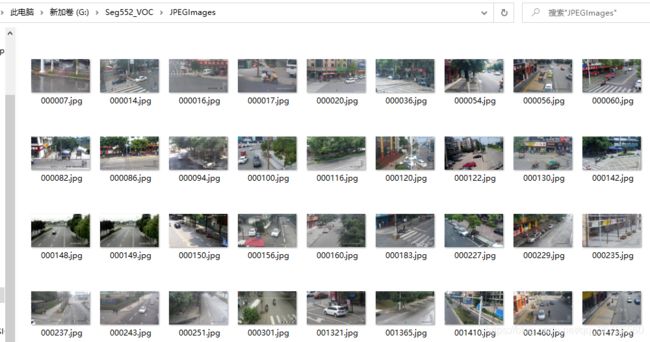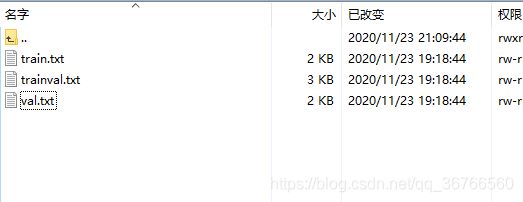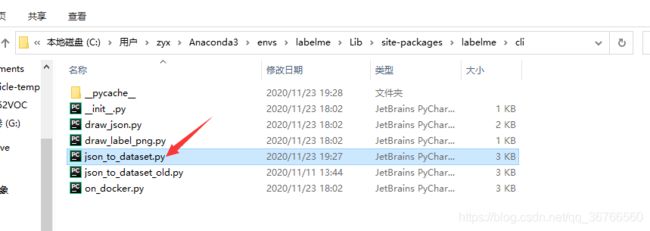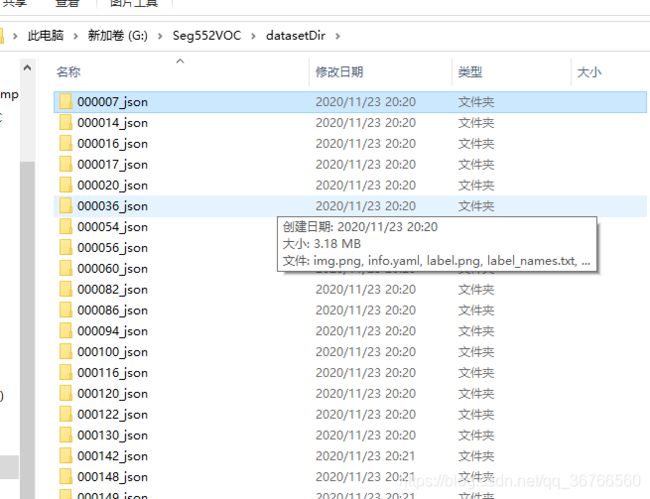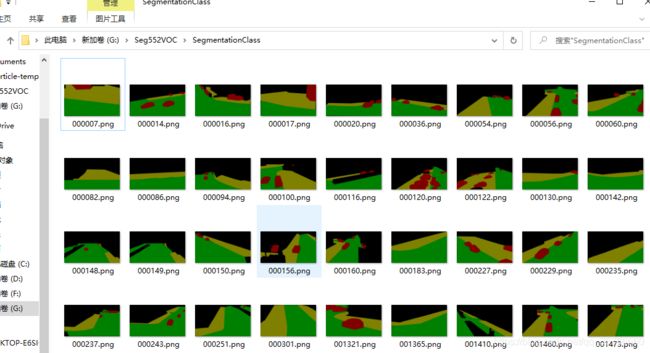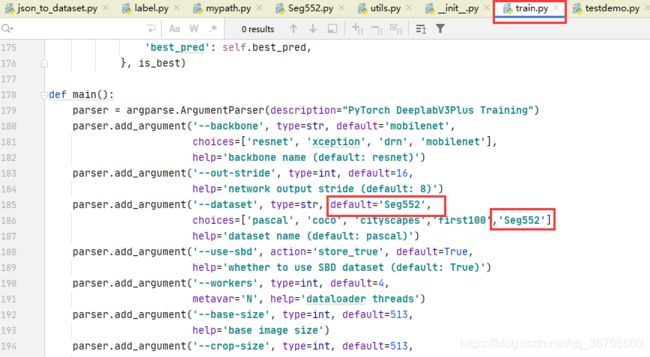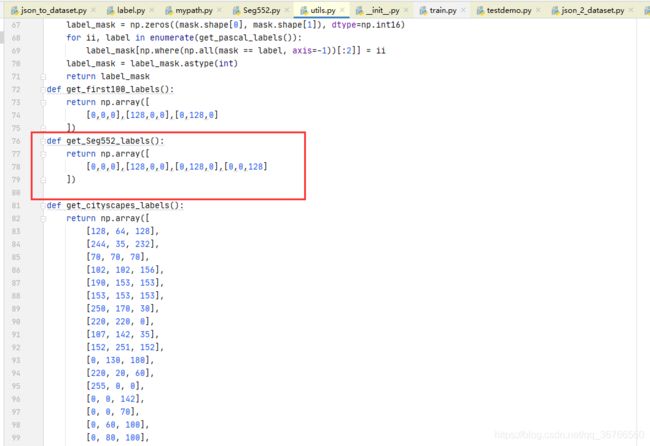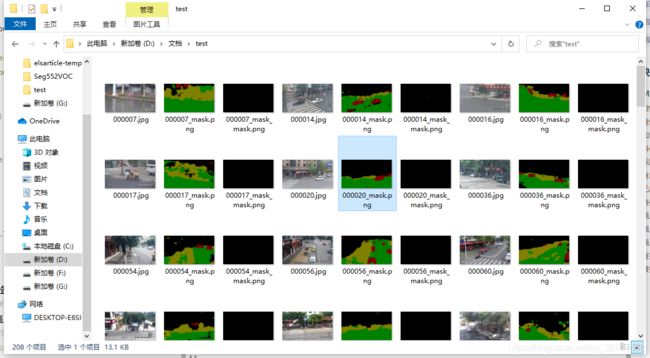Linux下Pytorch版deeplabv3+环境配置训练自己的数据集
Linux下Pytorch版deeplabv3+环境配置训练自己的数据集
-
- 开发环境
- 数据集准备
-
- 1.VOC数据集格式
-
- `JPEGImages`里面放原图
- `SegmentationClass`里面放对应的mask图片png格式,注意要和`JPEGImages`里的图片一一对应
- `ImageSets/ Segmentation`的txt文件中放去掉后缀的图片名
- 2.json转换mask图片
- 3.提取出所有文件夹中的`label.png`并改成对应的名字放在指定目录中
- 修改代码
-
- 1.在`mypath.py`中添加自己的数据集名称与路径
- 2.在同级目录中修改`train.py`约185行添加自己数据集的名称(可以设置为默认)
- 3.在dataloaders目录下修改__init__.py
- 4. 修改dateloaders目录下`utils.py`
- 5.在dataloaders/datasets目录下添加文件
- 运行并测试
-
- 1.开始训练
- 2.测试
开发环境
我使用的是实验室服务器的环境:
- CentOS(windows也可)
- pytorch-gpu1.7
- python3.7
代码在这:链接
数据集准备
1.VOC数据集格式
文件安排如下:
- ImageSets
- Segmentation
- train.txt
- trainval.txt
- val.txt
- JPEGImages
- SegmentationClass
JPEGImages里面放原图
SegmentationClass里面放对应的mask图片png格式,注意要和JPEGImages里的图片一一对应
ImageSets/ Segmentation的txt文件中放去掉后缀的图片名
2.json转换mask图片
数据转换参考的这里
- 用下面的代码替换labelme环境下的对应文件
Anaconda3\envs\labelme\Lib\site-packages\labelme\cli(注意替换掉path的路径,换上自己的json文件路径)
import argparse
import base64
import json
import os
import os.path as osp
import PIL.Image
import yaml
from labelme.logger import logger
from labelme import utils
path = "G:/Seg552VOC/seg552Json"
dirs = os.listdir(path)
def label(json_file, out_dir, label_name_to_value):
data = json.load(open(json_file))
if data['imageData']:
imageData = data['imageData']
else:
imagePath = os.path.join(os.path.dirname(json_file), data['imagePath'])
with open(imagePath, 'rb') as f:
imageData = f.read()
imageData = base64.b64encode(imageData).decode('utf-8')
img = utils.img_b64_to_arr(imageData)
for shape in sorted(data['shapes'], key=lambda x: x['label']):
label_name = shape['label']
if label_name in label_name_to_value:
label_value = label_name_to_value[label_name]
else:
label_value = len(label_name_to_value)
label_name_to_value[label_name] = label_value
lbl = utils.shapes_to_label(img.shape, data['shapes'], label_name_to_value)
label_names = [None] * (max(label_name_to_value.values()) + 1)
for name, value in label_name_to_value.items():
label_names[value] = name
lbl_viz = utils.draw_label(lbl, img, label_names)
PIL.Image.fromarray(img).save(osp.join(out_dir, 'img.png'))
utils.lblsave(osp.join(out_dir, 'label.png'), lbl)
PIL.Image.fromarray(lbl_viz).save(osp.join(out_dir, 'label_viz.png'))
with open(osp.join(out_dir, 'label_names.txt'), 'w') as f:
for lbl_name in label_names:
f.write(lbl_name + '\n')
logger.warning('info.yaml is being replaced by label_names.txt')
info = dict(label_names=label_names)
with open(osp.join(out_dir, 'info.yaml'), 'w') as f:
yaml.safe_dump(info, f, default_flow_style=False)
logger.info('Saved to: {}'.format(out_dir))
def main():
logger.warning('This script is aimed to demonstrate how to convert the'
'JSON file to a single image dataset, and not to handle'
'multiple JSON files to generate a real-use dataset.')
parser = argparse.ArgumentParser()
parser.add_argument('json_file_dir')
parser.add_argument('-o', '--out', default=None)
args = parser.parse_args()
label_name_to_value = {
'_background_': 0}
for json_file in dirs:
if args.out is None:
out_dir = osp.basename(json_file).replace('.', '_')
out_dir = osp.join(osp.dirname(json_file), out_dir)
else:
out_dir = args.out
if not osp.exists(out_dir):
os.mkdir(out_dir)
label(json_file, out_dir, label_name_to_value)
if __name__ == '__main__':
main()
3.提取出所有文件夹中的label.png并改成对应的名字放在指定目录中
label.py代码如下:
import os
import shutil
inputdir = 'G:/Seg552VOC/datasetDir'
outputdir = 'G:/Seg552VOC/ImageSetNew'
for dir in os.listdir(inputdir):
# 设置旧文件名(就是路径+文件名)
oldname = inputdir + os.sep + dir + os.sep + 'label.png' # os.sep添加系统分隔符
# 设置新文件名
newname = outputdir + os.sep + dir.split('_')[0] + '.png'
shutil.copyfile(oldname, newname) # 用os模块中的rename方法对文件改名
print(oldname, '======>', newname)
修改代码
参考博客:链接
1.在mypath.py中添加自己的数据集名称与路径
2.在同级目录中修改train.py约185行添加自己数据集的名称(可以设置为默认)
3.在dataloaders目录下修改__init__.py
在第一行添加数据集名称,复制'pascal'数据集描述,把名称修改为自己数据集的名字
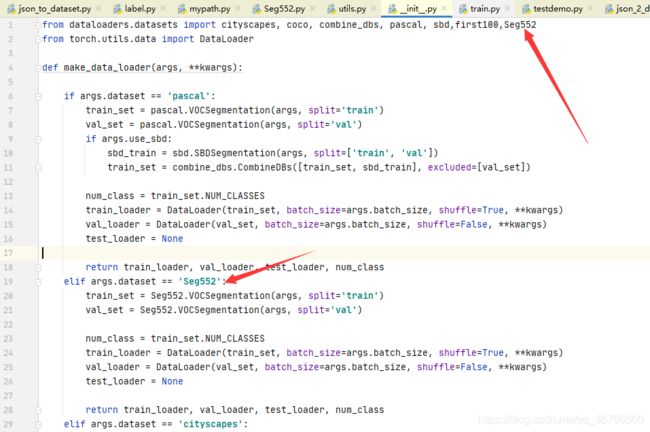
4. 修改dateloaders目录下utils.py
在24行左右添加代码,其中n_classes是你要分割的类别数

5.在dataloaders/datasets目录下添加文件
复制一份pascal.py,并重命名文件
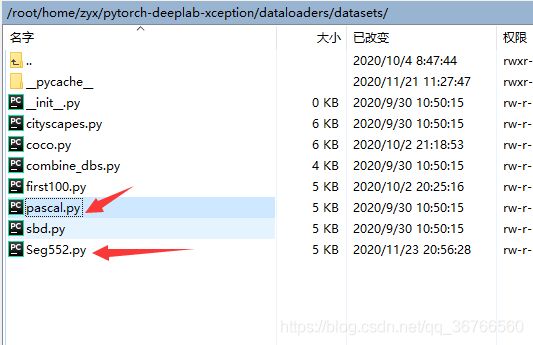
修改里面的类别数和数据集名称
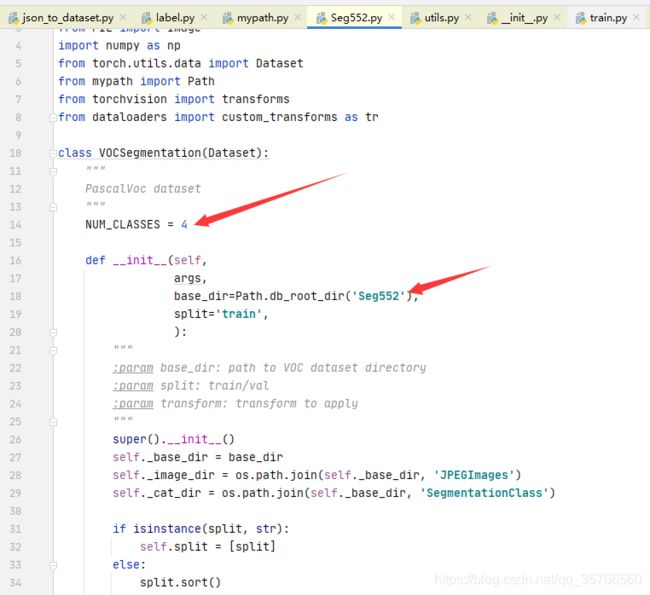
运行并测试
1.开始训练
运行指令如下
python train.py --backbone mobilenet --lr 0.007 --workers 1 --epochs 50 --batch-size 8 --gpu-ids 0 --checkname deeplab-mobilenet
–backbone mobilenet 指的是使用mobilenet作为backbone
–gpu-ids 0 指定gpu
–checkname deeplab-mobilenet 使用mobilenet预训练模型
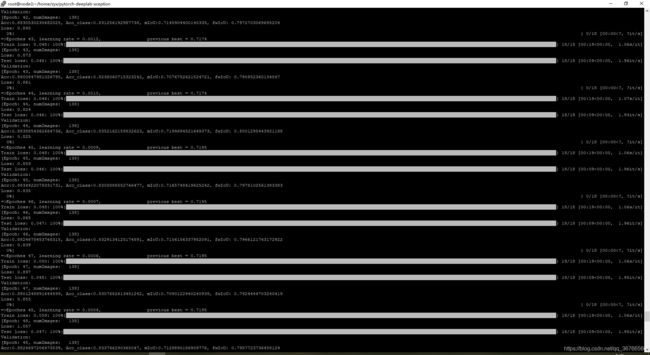
2.测试
测试testdemo.py
修改–in-path为数据集的测试图片,最后的结果保存在–in-path中
#
# demo.py
#
import argparse
import os
import numpy as np
import time
from modeling.deeplab import *
from dataloaders import custom_transforms as tr
from PIL import Image
from torchvision import transforms
from dataloaders.utils import *
from torchvision.utils import make_grid, save_image
def main():
parser = argparse.ArgumentParser(description="PyTorch DeeplabV3Plus Training")
parser.add_argument('--in-path', type=str, default='/root/home/zyx/Seg552_VOC/test',
help='image to test')
# parser.add_argument('--out-path', type=str, required=True, help='mask image to save')
parser.add_argument('--backbone', type=str, default='resnet',
choices=['resnet', 'xception', 'drn', 'mobilenet'],
help='backbone name (default: resnet)')
parser.add_argument('--ckpt', type=str, default='deeplab-resnet.pth',
help='saved model')
parser.add_argument('--out-stride', type=int, default=16,
help='network output stride (default: 8)')
parser.add_argument('--no-cuda', action='store_true', default=False,
help='disables CUDA training')
parser.add_argument('--gpu-ids', type=str, default='0',
help='use which gpu to train, must be a \
comma-separated list of integers only (default=0)')
parser.add_argument('--dataset', type=str, default='pascal',
choices=['pascal', 'coco', 'cityscapes','invoice'],
help='dataset name (default: pascal)')
parser.add_argument('--crop-size', type=int, default=513,
help='crop image size')
parser.add_argument('--num_classes', type=int, default=4,
help='crop image size')
parser.add_argument('--sync-bn', type=bool, default=None,
help='whether to use sync bn (default: auto)')
parser.add_argument('--freeze-bn', type=bool, default=False,
help='whether to freeze bn parameters (default: False)')
args = parser.parse_args()
args.cuda = not args.no_cuda and torch.cuda.is_available()
if args.cuda:
try:
args.gpu_ids = [int(s) for s in args.gpu_ids.split(',')]
except ValueError:
raise ValueError('Argument --gpu_ids must be a comma-separated list of integers only')
if args.sync_bn is None:
if args.cuda and len(args.gpu_ids) > 1:
args.sync_bn = True
else:
args.sync_bn = False
model_s_time = time.time()
model = DeepLab(num_classes=args.num_classes,
backbone=args.backbone,
output_stride=args.out_stride,
sync_bn=args.sync_bn,
freeze_bn=args.freeze_bn)
ckpt = torch.load(args.ckpt, map_location='cpu')
model.load_state_dict(ckpt['state_dict'])
model = model.cuda()
model_u_time = time.time()
model_load_time = model_u_time-model_s_time
print("model load time is {}".format(model_load_time))
composed_transforms = transforms.Compose([
tr.Normalize(mean=(0.485, 0.456, 0.406), std=(0.229, 0.224, 0.225)),
tr.ToTensor()])
for name in os.listdir(args.in_path):
s_time = time.time()
image = Image.open(args.in_path+"/"+name).convert('RGB')
# image = Image.open(args.in_path).convert('RGB')
target = Image.open(args.in_path+"/"+name).convert('L')
sample = {
'image': image, 'label': target}
tensor_in = composed_transforms(sample)['image'].unsqueeze(0)
model.eval()
if args.cuda:
tensor_in = tensor_in.cuda()
with torch.no_grad():
output = model(tensor_in)
grid_image = make_grid(decode_seg_map_sequence(torch.max(output[:3], 1)[1].detach().cpu().numpy()),
3, normalize=False, range=(0, 255))
save_image(grid_image,args.in_path+"/"+"{}_mask.png".format(name[0:-4]))
u_time = time.time()
img_time = u_time-s_time
print("image:{} time: {} ".format(name,img_time))
# save_image(grid_image, args.out_path)
# print("type(grid) is: ", type(grid_image))
# print("grid_image.shape is: ", grid_image.shape)
print("image save in in_path.")
if __name__ == "__main__":
main()
# python demo.py --in-path your_file --out-path your_dst_file
测试命令
python testdemo.py --ckpt run/Seg552/deeplab-mobilenet/checkpoint.pth.tar --backbone mobilenet
参考博客:
Pytorch 语义分割DeepLabV3+ 训练自己的数据集 从数据准备到模型训练
【windows10】使用pytorch版本deeplabv3+训练自己数据集
制作自己的语义分割数据集(仿voc2012数据集)
